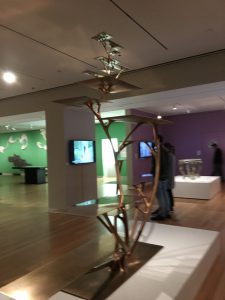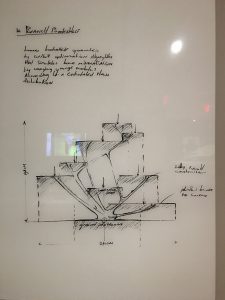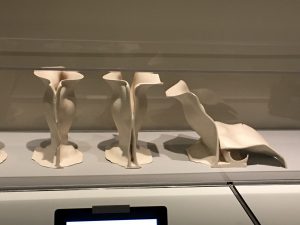For this semester, we were required to visit Cooper Hewitt.It’s not my first time at Cooper Hewitt, so the location wasn’t foreign to besides the rotating exhibits.
Cooper Hewitt Smithsonian Design Museum is located in Upper East side of Manhattan in New York City at 2 E 91st St, New York, NY 10128. They are open Weekdays 10AM-6PM, Saturdays 10AM-9PM, and Sundays 10AM-PM. Tickets are priced at $16 for Adults, but if you show your student ID you pay only $7. (However, I was charged $9 the time I went even with a student ID) If you really don’t want to pay anything or can’t afford it, on Saturdays 6PM-9PM is pay-what-you-wish admission.
I decided to visit Cooper Hewitt on November 2nd, 2017 mainly for the exhibit Joris Laarman Lab: Design in the Digital Age. Based on the brief summary of found in the Joris Laarman Lab, Jois Laarman Lab was founded in 2004 by a Dutch designer Joris Laarman and filmmaker Anita Star. Their approach is to focus on testing new technologies and production methods. His team references historical pieces in their work that connects present to the past.
It’s located on the 3rd floor of Cooper Hewitt. It’s open through January 15, 2018. My first impression of the exhibit is that it’s very spacious and full of interesting freeform modern pieces. Most of them were supposed to be furnitures like tables and chairs. Some of my favorite pieces were the 3 tables that referenced Super Mario. For the medium, they used 3 different sized cubes (NICKEL-PLATED NEODYMIUM VOXELS 10MM, 5MM, & 3MM) It was created in 2011 and drew reference from Super Mario like the clouds, piranha, flowers, and swallow.
Because I grew up playing Super Mario and love animation & games, these particular pieces drew me to it automatically. At first, I didn’t notice the 3 different sized nickel cubes and thought “Oh, they must have created 3 identical tables” but as I stared at it closer I noticed that it felt more “pixelated”. Also, the big purple mural of Super Mario (Wall Graphic, The Evolution of Super Mario) drew me in first as I walked inside the exhibit. The digital print (vinyl) on the wall was created in 2015 and Joris Laarman Lab decided to show the progression of how Super Mario looked from when it first debuted in 1986 pixelated 2D rendition to the current 3D rendition of Super Mario.

Another one of my favorite pieces is Bookshelf, Branch, 2010. It was created in 2010 by Joris Laarman Lab that uses Bronze as it’s medium. My first impression was that it looks like a bonsai tree and would be great as a decoration if you have space. It’s really big and almost touches the top. I didn’t think it was a bookshelf, but it was.

There was also a Sketch, Branch Bookshelf that shows the brainstorming of how this bookshelf was conceptually designed and why they did it. I didn’t notice it at first, but a security guard kindly told me since it was off on a wall that you wouldn’t think it would be connected to the bookshelf.
“Bronze bookshelf generates by softkill(?) optimization algorythm (?) that simulates bone mineralization by varying young modules according to a calculated stress distribution”
“Silky finish construction & polished bronze top surface”

Another piece I found at the end of the exhibit in the corner is Limited: Dying Vases. It was created in 2003 and uses cast ceramic as it’s medium.


I was intrigued by the phases the vase goes through as it dies from causes like deterioration from mold. Starting from the left, the vase starts out normal but with each vase to the right, you can see its getting more eroded. The last stage is really interesting. I thought it was a mini freeform chair, but in reality it’s an eroded ceramic vase.
To my surprise there was a exhibit relating to Japanese antiques called Passion for the Exotic: Japonism. I love Japanese culture and I visit it yearly because every time I visit I learn and get inspired even more. Nothing is the same every visit and is also a memorable experience.
This exhibit runs through June 18, 2018 and is located on the 2nd floor of Cooper Hewitt in a small room. It’s has many home goods such as plates, knives, teapot, vases, cups, bowls, etc. One of my favorite pieces from this exhibit is the Teapot, 1888. It’s part of a tea set collection such as coffee pot, tea cup, cream pitcher, sugar bowl, and waste bowl.

It was created in 1888 and uses cast, chased, repoussé silver, ivory as it’s medium.
My overall experience this time at Cooper Hewitt was fun. There’s always at least 1 exhibit in Cooper Hewitt that I like and would continue to support this place again.


